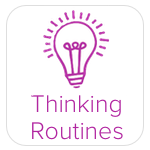- STEP 1: Explain that students should be totally silent during this activity except for when it is their turn. Have all students gather in a circle facing inward.
- STEP 2: Choose one student to step into the middle of the circle and exclaim “I’m a bird” while taking the shape of a bird and holding that shape. The student who is a “bird” stays frozen in the center of the circle (this is called a tableau) as students take turns going around the circle in a clockwise direction and adding to the existing scene. For example the next student might step out and say “I’m a seed” and curl up into a ball on the ground beside the bird. Now both the “bird” and the “seed” will stay frozen in the circle as students continue to add to the scene.
- STEP 3: Once all students are part of the tableau for an added challenge tell them that they are going to become a silent moving picture and that they are going to stay in character as their object but begin to move about the scene they have created.
- STEP 4: To take this even further, you can have students think of what sounds or words they might say as their character. Go around the tableau and tap each student on the shoulder one at a time. As students are tapped they may make a sound or say a few words as their character. Then they must step back into the scene and become silent and still once again as the teacher moves around to tap other student’s shoulders.
LESSON IDEA:
Explore a narrative or informational text from different points of view using this warm-up. Students can show their point of view through a tableau and a short description when tapped.
EXTENSION:
This warm up provides a solid foundation for any lesson that involves tableau or characterization. Tip: Avoid telling students that they are “wrong” or that their imagined characters don’t “fit” with this particular tableau- instead try to embrace all school-appropriate responses as creative contributions.
 |  |  |
